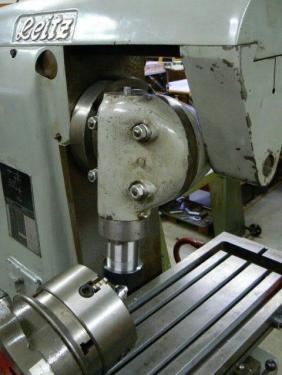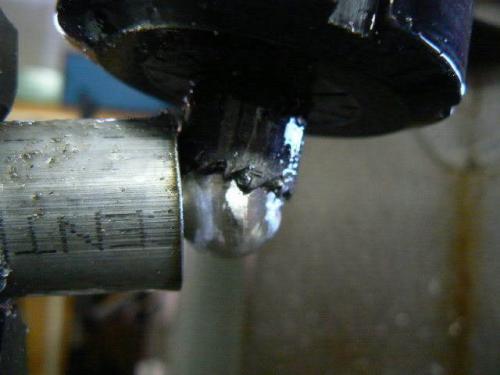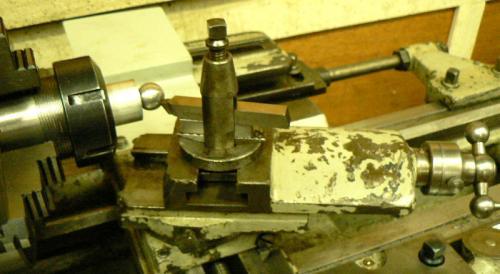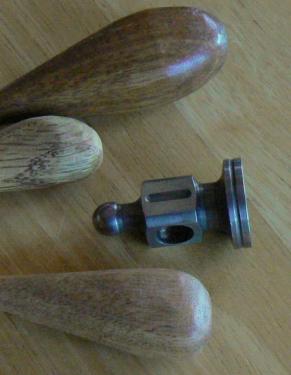This reminds me of the traditional method of cutting convex and concave shapes. I’ll get to that in a minute but first a weird setup that I came up with five or ten years ago, after obtaining my universal-horizontal mill.
The setup can be replicated in any vertical mill, I just happened to have a vertical head installed so I grunted the 60 pound rotary table plus 4-jaw chuck onto the table and cut a decorative ball.
Initial setup consists of adjusting the angle between the rotary table and the spindle, then establishing the correct offset distance. While rotating the table (by hand or otherwise) a cutting tool is lowered onto the workpiece. A small hole-saw was used when the photo was taken but a boring head is preferred for versatility – a hole saw is limited to a single diameter of ball it can produce and is limited in precision.


It’s a cumbersome way to make a ball but there is one advantage: it produces a truly round ball because any errors in the process are averaged out after a few rotations of the table. Dimension and concentricity due to rotary table bearing, spindle bearing, runout of cutting tool, etcetera, are averaged if enough rotations of the table are made because the errors are unrelated to one another.
The normal boring head isn’t a precisely adjustable device, achievable diametric tolerances are probably in the order of two or three mils, spending a reasonable amount of time. Somewhere on my computer is the sketch that I made with the formulas for the angles and dimensions to obtain a ball of any specific diameter.
Oh yeah, the cutting tool must be LH cutting not the normal RH tool. Easy enough to grind one quickly. A normal LH lathe cutting tool can be used in place of a boring tool, BTW, provided that front clearance is reasonable.
Ball turner 2 is the traditional method using the (always-versatile) lantern tool post and by rotating the compound rest. Generally the cutting tool is just held in the lantern and not in an Armstrong tool holder. This technique cannot be used to turn balls using a QCTP or a four way – only concave configurations can be turned with these.
This was once the most common method of obtaining both concave and convex surfaces but with the advent of the QCTP and the disappearance of lantern tool posts, it has largely been forgotten hence the many ball-turner designs to be found on the internet.
This is a sketch of the process:


The compound lock screws must be loosened but snugged so that there is a slight drag when rotating the compound. The carriage should be locked to the ways before starting to cut. After each pass, the carriage lock is loosened, the carriage advanced to obtain the desired depth of cut, then locked again.
A simple way of setting the radius is to bring the cutting tool near a dead center held in the tailstock. Rotate the compound back and forth, measure the distance between cutting tool and tip of dead center. Adjust the center of the radius with the cross slide and adjust the radius dimension with the compound slide.
This is perfectly adequate for decorative balls that do not need a diameter more precise than what can be measured with a machinist’s scale. Other means must be used for making a more precise adjustment, the most common being similar to normal turning: cut the ball intentionally oversize, measure it and correct with the compound slide crank NOT the cross slide.
If it is not obvious, the pivot point of the compound slide is the center of the cutting radius and must be aligned with the lathe center line. For precise centering, use a DTI to check both sides of the (centered) workpiece. The compound is rotated 180 degrees for this measurement. Adjust cross slide to obtain equal readings on both sides. The lathe carriage may have to be moved in and out to prevent the DTI bottoming against the edges of the work.
The following photo is a jeweler’s chasing hammer that I made for my sister, the peening end was turned using the method described. Incidentally, the hammer head is about the size of my thumb. It was a simple project except for milling the conical-elliptical hole for the handle.

My sister is picky and wanted to try handles made from various wood species. I ended up making six before she was satisfied with the feel of the hammer. The above three are oak, western ash and myrtle.
The setup can be replicated in any vertical mill, I just happened to have a vertical head installed so I grunted the 60 pound rotary table plus 4-jaw chuck onto the table and cut a decorative ball.
Initial setup consists of adjusting the angle between the rotary table and the spindle, then establishing the correct offset distance. While rotating the table (by hand or otherwise) a cutting tool is lowered onto the workpiece. A small hole-saw was used when the photo was taken but a boring head is preferred for versatility – a hole saw is limited to a single diameter of ball it can produce and is limited in precision.
It’s a cumbersome way to make a ball but there is one advantage: it produces a truly round ball because any errors in the process are averaged out after a few rotations of the table. Dimension and concentricity due to rotary table bearing, spindle bearing, runout of cutting tool, etcetera, are averaged if enough rotations of the table are made because the errors are unrelated to one another.
The normal boring head isn’t a precisely adjustable device, achievable diametric tolerances are probably in the order of two or three mils, spending a reasonable amount of time. Somewhere on my computer is the sketch that I made with the formulas for the angles and dimensions to obtain a ball of any specific diameter.
Oh yeah, the cutting tool must be LH cutting not the normal RH tool. Easy enough to grind one quickly. A normal LH lathe cutting tool can be used in place of a boring tool, BTW, provided that front clearance is reasonable.
Ball turner 2 is the traditional method using the (always-versatile) lantern tool post and by rotating the compound rest. Generally the cutting tool is just held in the lantern and not in an Armstrong tool holder. This technique cannot be used to turn balls using a QCTP or a four way – only concave configurations can be turned with these.
This was once the most common method of obtaining both concave and convex surfaces but with the advent of the QCTP and the disappearance of lantern tool posts, it has largely been forgotten hence the many ball-turner designs to be found on the internet.
This is a sketch of the process:
The compound lock screws must be loosened but snugged so that there is a slight drag when rotating the compound. The carriage should be locked to the ways before starting to cut. After each pass, the carriage lock is loosened, the carriage advanced to obtain the desired depth of cut, then locked again.
A simple way of setting the radius is to bring the cutting tool near a dead center held in the tailstock. Rotate the compound back and forth, measure the distance between cutting tool and tip of dead center. Adjust the center of the radius with the cross slide and adjust the radius dimension with the compound slide.
This is perfectly adequate for decorative balls that do not need a diameter more precise than what can be measured with a machinist’s scale. Other means must be used for making a more precise adjustment, the most common being similar to normal turning: cut the ball intentionally oversize, measure it and correct with the compound slide crank NOT the cross slide.
If it is not obvious, the pivot point of the compound slide is the center of the cutting radius and must be aligned with the lathe center line. For precise centering, use a DTI to check both sides of the (centered) workpiece. The compound is rotated 180 degrees for this measurement. Adjust cross slide to obtain equal readings on both sides. The lathe carriage may have to be moved in and out to prevent the DTI bottoming against the edges of the work.
The following photo is a jeweler’s chasing hammer that I made for my sister, the peening end was turned using the method described. Incidentally, the hammer head is about the size of my thumb. It was a simple project except for milling the conical-elliptical hole for the handle.
My sister is picky and wanted to try handles made from various wood species. I ended up making six before she was satisfied with the feel of the hammer. The above three are oak, western ash and myrtle.




